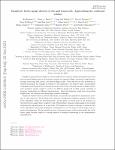Symplectic lattice gauge theories in the grid framework: Approaching the conformal window
| dc.contributor.author | Bennett, E | |
| dc.contributor.author | Boyle, PA | |
| dc.contributor.author | Del Debbio, L | |
| dc.contributor.author | Forzano, N | |
| dc.contributor.author | Hong, DK | |
| dc.contributor.author | Lee, J-W | |
| dc.contributor.author | Lenz, J | |
| dc.contributor.author | Lin, C-JD | |
| dc.contributor.author | Lucini, B | |
| dc.contributor.author | Lupo, A | |
| dc.contributor.author | Piai, M | |
| dc.contributor.author | Vadacchino, D | |
| dc.date.accessioned | 2024-03-15T09:38:26Z | |
| dc.date.available | 2024-03-15T09:38:26Z | |
| dc.date.issued | 2023-11-20 | |
| dc.identifier.issn | 2470-0010 | |
| dc.identifier.issn | 2470-0029 | |
| dc.identifier.other | 094508 | |
| dc.identifier.uri | https://pearl.plymouth.ac.uk/handle/10026.1/22194 | |
| dc.description.abstract |
Symplectic gauge theories coupled to matter fields lead to symmetry enhancement phenomena that have potential applications in such diverse contexts as composite Higgs, top partial compositeness, strongly interacting dark matter, and dilaton-Higgs models. These theories are also interesting on theoretical grounds, for example in reference to the approach to the large-N limit. A particularly compelling research aim is the determination of the extent of the conformal window in gauge theories with symplectic groups coupled to matter, for different groups and for field content consisting of fermions transforming in different representations. Such determination would have far-reaching implications, but requires overcoming huge technical challenges. Numerical studies based on lattice field theory can provide the quantitative information necessary to this endeavor. We developed new software to implement symplectic groups in the Monte Carlo algorithms within the Grid framework. In this paper, we focus most of our attention on the Sp(4) lattice gauge theory coupled to four (Wilson-Dirac) fermions transforming in the 2-index antisymmetric representation, as a case study. We discuss an extensive catalog of technical tests of the algorithms and present preliminary measurements to set the stage for future large-scale numerical investigations. We also include the scan of parameter space of all asymptotically free Sp(4) lattice gauge theories coupled to varying number of fermions transforming in the antisymmetric representation. | |
| dc.format.extent | 094508- | |
| dc.language | en | |
| dc.publisher | American Physical Society (APS) | |
| dc.subject | 5106 Nuclear and Plasma Physics | |
| dc.subject | 5107 Particle and High Energy Physics | |
| dc.subject | 4902 Mathematical Physics | |
| dc.subject | 49 Mathematical Sciences | |
| dc.subject | 51 Physical Sciences | |
| dc.title | Symplectic lattice gauge theories in the grid framework: Approaching the conformal window | |
| dc.type | journal-article | |
| dc.type | Article | |
| plymouth.issue | 9 | |
| plymouth.volume | 108 | |
| plymouth.publication-status | Published online | |
| plymouth.journal | Physical Review D | |
| dc.identifier.doi | 10.1103/physrevd.108.094508 | |
| plymouth.organisational-group | |Plymouth | |
| plymouth.organisational-group | |Plymouth|Faculty of Science and Engineering | |
| plymouth.organisational-group | |Plymouth|Faculty of Science and Engineering|School of Engineering, Computing and Mathematics | |
| plymouth.organisational-group | |Plymouth|REF 2021 Researchers by UoA | |
| plymouth.organisational-group | |Plymouth|Users by role | |
| plymouth.organisational-group | |Plymouth|Users by role|Academics | |
| plymouth.organisational-group | |Plymouth|REF 2021 Researchers by UoA|UoA10 Mathematical Sciences | |
| plymouth.organisational-group | |Plymouth|REF 2021 Researchers by UoA|ZZZ Extended UoA 10 - Mathematical Sciences | |
| plymouth.organisational-group | |Plymouth|REF 2029 Researchers by UoA | |
| plymouth.organisational-group | |Plymouth|REF 2029 Researchers by UoA|UoA10 Mathematical Sciences | |
| dcterms.dateAccepted | 2023-10-24 | |
| dc.date.updated | 2024-03-15T09:38:25Z | |
| dc.rights.embargodate | 2024-3-20 | |
| dc.identifier.eissn | 2470-0029 | |
| rioxxterms.versionofrecord | 10.1103/physrevd.108.094508 |


